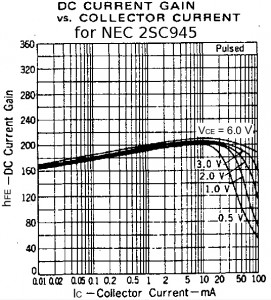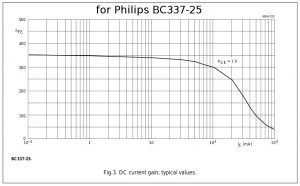 I blogged Anton’s HV JT and noticed that it uses a 2SC945. I googled for 2SC945 datasheet and found a .PDF of the datasheet from NEC. It showed that the absolute maximum collector current is 100 mA, which is way too low for a Joule Thief, which needs several hundred mA. I scrolled down to the page with the graphs and found one that said Current Gain VS Collector Current (see the attached picture).
I blogged Anton’s HV JT and noticed that it uses a 2SC945. I googled for 2SC945 datasheet and found a .PDF of the datasheet from NEC. It showed that the absolute maximum collector current is 100 mA, which is way too low for a Joule Thief, which needs several hundred mA. I scrolled down to the page with the graphs and found one that said Current Gain VS Collector Current (see the attached picture).
What we want for our JT is a transistor that has good current gain holdup at high currents and low collector voltage. At saturation, the collector voltage should be 1/4 volt or less at several hundred milliamps, and the gain should be reasonably close to what it is at much lower currents.
The Graph Doesn’t Lie – Looking at the graph, we see that it doesn’t go more than 100 mA on the right. That’s not enough for our JT. We notice that when the collector current is 10 mA, the current gain is about 180 at any collector voltage (Vce). But when the collector current goes up to 100 mA and the collector voltage goes down to 0.5V, the current gain has suffered greatly – only 50 which is less than 1/3 of its 10 mA value. And we’re going to want the transistor to have high current gain at 1/4 volt and 2 to 300 mA, which is even more demanding on the transistor. What the graph implies is that the 2SC945 was made for moderate currents much less than 100 mA, and was never meant to do an adequate job as a Joule Thief transistor.
 What to do? Let’s look at the datasheet for the Philips BC337-25. It shows the maximum collector current is 500 mA. five times that of the 2SC945. Then we look at the graph of current gain vs. collector current (see attached pic). The graph shows the beta (current gain) holdup at high currents and low voltage is much better than the 2SC945. In practice the BC337-25 will put out about 20 milliamps to the LED and draw about 80 milliamps from the battery. And it’s mre efficient than the 2N3904 or 2SC945.
What to do? Let’s look at the datasheet for the Philips BC337-25. It shows the maximum collector current is 500 mA. five times that of the 2SC945. Then we look at the graph of current gain vs. collector current (see attached pic). The graph shows the beta (current gain) holdup at high currents and low voltage is much better than the 2SC945. In practice the BC337-25 will put out about 20 milliamps to the LED and draw about 80 milliamps from the battery. And it’s mre efficient than the 2N3904 or 2SC945.











